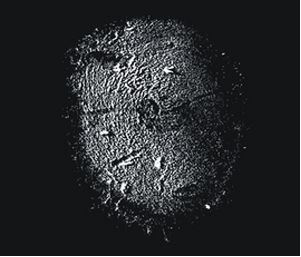Home > Press > First images of barnacle larva’s footprint
 |
| The footprint of the barnacle cyprid larva of approximately 30 micrometre, revealed by an Atomic Force Microscope. |
Abstract:
The fouling or growth of sea organisms, such as barnacles, on ships' hulls causes damage costing many billions of euros annually. In order to prevent this fouling, In Yee Phang of the University of Twente used nanotechnology to investigate how barnacles colonize a surface. This is the first time that the existence of barnacle cyprid larvae ‘footprints' has been demonstrated. Phang will be awarded his doctorate on 24 October at the faculty of Science and Technology.
First images of barnacle larva’s footprint
Netherlands | Posted on October 27th, 2008In order to be able to prevent barnacle adhesion to ships, we have to know how they attach themselves to surfaces. In Yee Phang therefore investigated the colonization process of barnacles. This process begins in the early stages of development when the larvae are still able to move freely.
Barnacle larvae are about a half a millimetre in size and do not yet have a shell. They can swim, but they can also move over a surface. They do so by temporarily clamping themselves to the surface in question by exuding a sticky substance, a sort of protein-based biological cement. The mark left by this cement on a surface is known as a ‘footprint'. This footprint contains chemical substances that attract other larvae. The first footprint on a surface is therefore the first step in the colonization of the surface concerned.
Scientists have suspected the existence of a larval footprint for some time, but this had not yet been directly demonstrated. Using nanotechnology, Phang was able to reveal footprints measuring approximately 30 micrometre for the first time. He achieved this using an Atomic Force Microscope (AFM). This is a microscope that explores a surface and ascertains differences in height with a miniscule needle. Not only does this enable one to observe extremely small objects, but this research can also be carried out in the original environment, in this case, seawater.
Barnacles
Barnacles are hermaphroditic animals that are about a centimetre in size with a calcium carbonate skeleton that looks like a shell. They anchor themselves to surfaces just like mussels. The adhesion of barnacles to ships' hulls causes damage costing many billions of euros annually. The shells increase the friction between the hull and water so that the ship uses more fuel. Furthermore, it is difficult, and consequently expensive, to remove the shells from ships' hulls.
Note for the press
In Yee Phang (1976, Ipoh, Malaysia) carried out his PhD research in the research group Materials Science and Technology of Polymers, at the Faculty of Science and Technology and the Mesa+ Research Institute at the University of Twente, the Netherlands. The study was financed by the Dutch Polymer Institute. In Yee Phang carried out his research under the supervision of Prof. G.J. Vancso. His thesis, and a summary of the thesis, are available in digital form.
####
For more information, please click here
Contacts:
Joost Bruysters
tel +31 (0)53 4892773
or
Wiebe van der Veen
tel +31 (0)53 4894244
Copyright © University of Twente
If you have a comment, please Contact us.Issuers of news releases, not 7th Wave, Inc. or Nanotechnology Now, are solely responsible for the accuracy of the content.
| Related News Press |
News and information
![]() Researchers develop molecular qubits that communicate at telecom frequencies October 3rd, 2025
Researchers develop molecular qubits that communicate at telecom frequencies October 3rd, 2025
![]() Next-generation quantum communication October 3rd, 2025
Next-generation quantum communication October 3rd, 2025
![]() "Nanoreactor" cage uses visible light for catalytic and ultra-selective cross-cycloadditions October 3rd, 2025
"Nanoreactor" cage uses visible light for catalytic and ultra-selective cross-cycloadditions October 3rd, 2025
Marine/Watercraft
![]() Strain-sensing smart skin ready to deploy: Nanotube-embedded coating detects threats from wear and tear in large structures July 15th, 2022
Strain-sensing smart skin ready to deploy: Nanotube-embedded coating detects threats from wear and tear in large structures July 15th, 2022
![]() A sunlight-driven “self-healing” anti-corrosion coating May 27th, 2022
A sunlight-driven “self-healing” anti-corrosion coating May 27th, 2022
![]() Quantum tech in space? Scientists design remote monitoring system for inaccessible quantum devices February 11th, 2022
Quantum tech in space? Scientists design remote monitoring system for inaccessible quantum devices February 11th, 2022
Discoveries
![]() Researchers develop molecular qubits that communicate at telecom frequencies October 3rd, 2025
Researchers develop molecular qubits that communicate at telecom frequencies October 3rd, 2025
![]() Next-generation quantum communication October 3rd, 2025
Next-generation quantum communication October 3rd, 2025
![]() "Nanoreactor" cage uses visible light for catalytic and ultra-selective cross-cycloadditions October 3rd, 2025
"Nanoreactor" cage uses visible light for catalytic and ultra-selective cross-cycloadditions October 3rd, 2025
Announcements
![]() Rice membrane extracts lithium from brines with greater speed, less waste October 3rd, 2025
Rice membrane extracts lithium from brines with greater speed, less waste October 3rd, 2025
![]() Researchers develop molecular qubits that communicate at telecom frequencies October 3rd, 2025
Researchers develop molecular qubits that communicate at telecom frequencies October 3rd, 2025
![]() Next-generation quantum communication October 3rd, 2025
Next-generation quantum communication October 3rd, 2025
![]() "Nanoreactor" cage uses visible light for catalytic and ultra-selective cross-cycloadditions October 3rd, 2025
"Nanoreactor" cage uses visible light for catalytic and ultra-selective cross-cycloadditions October 3rd, 2025
|
|
||
|
|
||
| The latest news from around the world, FREE | ||
|
|
||
|
|
||
| Premium Products | ||
|
|
||
|
Only the news you want to read!
Learn More |
||
|
|
||
|
Full-service, expert consulting
Learn More |
||
|
|
||








